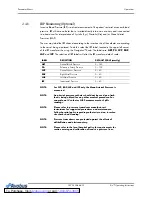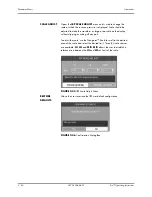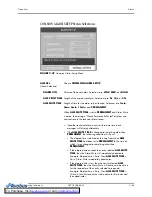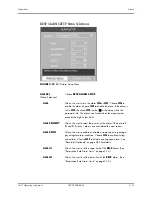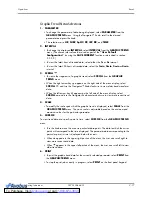
Trio™ Operating Instructions
0070-10-0666-01
2 - 63
Operations
Alarms
2.5
Alarms
The
Trio
provides audio and visual alarms to indicate:
• The functional status of the monitor
• That the measured parameter values are equal to or exceed the alarm limits
These alarms are divided into three categories: Physiological, Technical and General. Alarms
in each category are classified in one of three levels based on their degree of severity. These
levels are Priority 1, 2 or 3.
When the
Trio
is turned ON, an audible tone and the alarm light will indicate that the audio
and visual alarm functions of the monitor are working properly. If the tone is not heard and/
or the alarm light does not flash when the unit is turned ON, contact the hospital biomedical
technician or a Customer Service representative.
Technical and General alarm messages will display in the message area located in the upper
right portion of the
Trio
display, with the exception of the NIBP technical alarms. NIBP
technical alarms will display at the bottom of the NIBP parameter tile.
2.5.1
Alarm Categories
Physiological Alarms
Physiological alarms are alarms prompted by changes in the patient's medical condition.
These alarms occur when the patient’s vital signs are equal to or exceed set alarm limits.
Alarm limits are available for Heart Rate (HR), Systolic (SYS) blood pressure, Diastolic (DIA)
blood pressure, Mean Arterial Pressure (MEAN), Respiration (RESP), SpO
2
and Temperature
(TEMP). All of these alarm limits have an
OFF
selection with the exception of SpO
2
alarm
low. Each of these parameters has default alarm limits. However, parameter alarm limits can
be customized based on the individual patient's needs.
NOTE:
In the French configuration, the HR (Heart Rate) alarm is
always ON. It cannot be disabled by turning it OFF.
A physiological alarm will occur when the parameter alarm is set to
ON
and the measured value
is equal to or exceeds the set alarm limit. Alarms will not activate if the alarm is set to
OFF
.
If
ALARM PRINT
is set to
ON
for a given parameter, a printed record will automatically be
generated when the parameter value is equal to or exceeds the set alarm limits.
Technical Alarms
Technical alarms refer to a communication error or functional failure, which require resolution
or attention to continue patient monitoring. Technical alarms are also called System Errors.
Upon detecting a system error, the monitor alarms immediately. If more than one (1) technical
alarm occurs, each alarm will cycle until the associated error is resolved.








